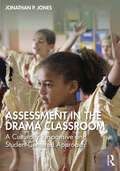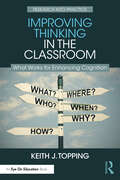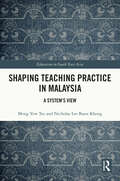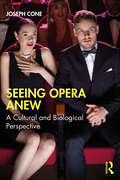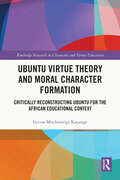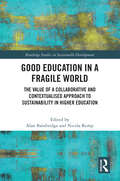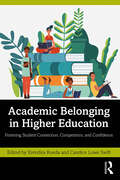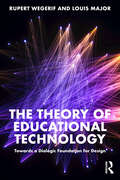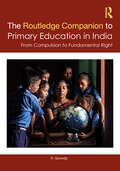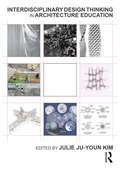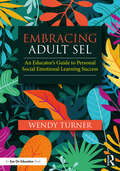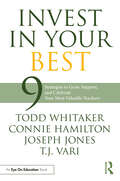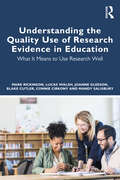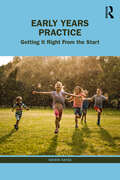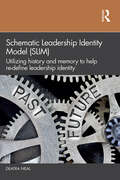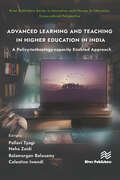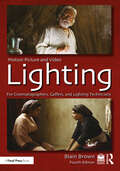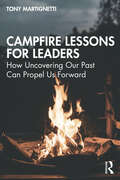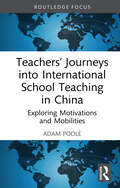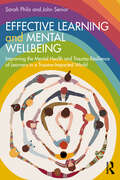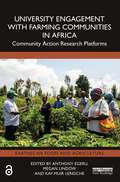- Table View
- List View
Assessment in the Drama Classroom: A Culturally Responsive and Student-Centered Approach
by Jonathan P. JonesThis textbook offers a practical approach for designing and implementing assessment for learning in the drama classroom. Assessment in the Drama Classroom begins with a theoretical overview that covers the purpose of assessment with student-centered, culturally responsive methods. The following chapters present an in-depth analysis of how to organize drama curriculum, develop measurable learning objectives, and implement a backward planning approach to summative assessment. Models and tools for generating diagnostic, formative, and summative assessments for various grade levels invite the reader to adapt these approaches to their classrooms. Ideal for drama education and pedagogy courses, this book is an accessible tool for drama educators to engage in critical reflection on assessment. Drama educators will find methods and suggestions for reimagining their assessment practices and be empowered to meet the learning needs of their students.
Assessment in the Drama Classroom: A Culturally Responsive and Student-Centered Approach
by Jonathan P. JonesThis textbook offers a practical approach for designing and implementing assessment for learning in the drama classroom.Assessment in the Drama Classroom begins with a theoretical overview that covers the purpose of assessment with student-centered, culturally responsive methods. The following chapters present an in-depth analysis of how to organize drama curriculum, develop measurable learning objectives, and implement a backward planning approach to summative assessment. Models and tools for generating diagnostic, formative, and summative assessments for various grade levels invite the reader to adapt these approaches to their classrooms.Ideal for drama education and pedagogy courses, this book is an accessible tool for drama educators to engage in critical reflection on assessment. Drama educators will find methods and suggestions for reimagining their assessment practices and be empowered to meet the learning needs of their students.
Improving Thinking in the Classroom: What Works for Enhancing Cognition
by Keith J. ToppingPrograms like philosophy for children, reciprocal teaching, problem based learning and computerized games can help students’ critical and creative thinking skills, but which are most effective? This research-to-practice book showcases how you can improve the thinking (cognition) of your students, across the curriculum and beyond. Each chapter focuses on a particular program, describes the method and background research, offers examples and explains key processes in implementation. You'll learn about thinking programs within a subject, across the curriculum, outside the curriculum and those which can be either within or outside the curriculum, so you can choose a program which suits your context. You’ll also find out what to consider when evaluating a thinking skills program. And finally, you’ll discover shared features of the methods – such as peer interaction, discourse, argumentation, scaffolding and transfer – so you can see the commonalities of the programs and think about designing your own approaches. Whether you’re a classroom teacher, department head, or other key stakeholder, this powerful resource will help you determine what really works for teaching thinking, so your students can apply such skills and thrive long after they’ve left school. Note: This book is part of a set; a companion book focuses on programs for teaching metacognition, or thinking about thinking.
Shaping Teaching Practice in Malaysia: A System's View (Education in South East Asia)
by Meng Yew Tee Nicholas Lee Boon KhengWhat teachers do in the classroom is one of the most significant school-based factors in shaping student learning. Yet the classroom is often referred to as a 'black box' because there's so little we know about what actually happens there. This book provides insights into the ‘black box’ by describing and then comparing classroom practices in Malaysia’s national public school system and that of a unique subsystem situated within it. Through analysis of hundreds of hours of classroom video data, as well as interviews, this book goes on to identify and discuss the forces that shape teachers' classroom practices from across the ecological system. What emerged were nuanced insights of how tightly and loosely coupled forces within the centralised Malaysian national system shaped these teachers’ classroom practices, that are illustrated in multiple case studies. Additionally, this volume uncovers micro-disruptions to some tightly-coupled forces within the system that could begin to change teachers’ thinking about their classroom practice. These insights will be of interest to international and comparative education researchers, education policy makers and education professionals as well as anyone who has ever asked the question "Why do teachers do what they do in their classrooms?"
Seeing Opera Anew: A Cultural and Biological Perspective
by Joseph ConeWhat people ultimately want from opera, audience research suggests, is to be absorbed in a story that engages their feelings, even moves them deeply, and that may lead them to insights about life and, perhaps, themselves. How and why can this combination of music and drama do that? What causes people to be moved by opera? How is it that people may become more informed about living and their own lives? Seeing Opera Anew addresses these fundamental questions. Most approaches to opera present information solely from the humanities, providing musical, literary, and historical interpretations, but this book offers a “stereo” perspective, adding insights from the sciences closely related to human life, including evolutionary biology, psychology, anthropology, and neuroscience. It can be hoped that academic specialists less familiar with the science will find points of interest in this book’s novel approach, and that open-minded students and inquisitive opera-goers will be stimulated by its “cultural and biological perspective.”
Ubuntu Virtue Theory and Moral Character Formation: Critically Reconstructing Ubuntu for the African Educational Context (Routledge Research in Character and Virtue Education)
by Grivas Muchineripi KayangeThis book investigates the ubuntu theory-based conception of virtue and moral character formation in the northern, western, and eastern regions of Africa, suggesting a critical reconstruction of ubuntu by conceptualising the four different forms of practices in moral character formation. Arguing for the critical reconstruction of ubuntu virtue theory as more nuanced than simply the standard ubuntu normative virtue theories (which give priority to the community as the sole locus for understanding virtues and character formation in Africa), the book builds a comprehensive model of virtue and moral character formation that draws insights from the reconstructed notion of ubuntu and other theories within and beyond the African thought. Chapters feature experience from across Africa including Malawi, Zambia, Zimbabwe, Uganda, Kenya, and South Africa, and centre on topics such as traditional cultural views and practices, political systems in various nations, neoliberalist thought, and primary, secondary and tertiary education systems in Africa and further afield. This is a valuable resource for scholars, academics, and postgraduate students, working in the fields of moral and values education, philosophy of education, and the theory of education more broadly. Those also interested in educational psychology may also find the volume of interest.
Good Education in a Fragile World: The Value of a Collaborative and Contextualised Approach to Sustainability in Higher Education (Routledge Studies in Sustainable Development)
by Alan Bainbridge Nicola KempThis edited collection aims to provoke discussion around the most important question for contemporary higher education – what kind of education (in terms of purpose, pedagogy and policy) is needed to restore the health and wellbeing of the planet and ourselves now and for generations to come? The book contains contributions from colleagues at a single UK University, internationally recognised for its approach to sustainability education. Introducing a conceptual framework called the ‘Paradox Model’, the book explores the tensions that underpin the challenge of developing sustainability in higher education in the 21st century. It asks probing questions about the purpose of higher education in the 21st century given growing concerns in relation to planetary safety and justice and calls for a rethinking of educational purpose. It draws upon the theory and practice of education and explores how these can develop an understanding of sustainability pedagogies in practice. Finally, it delivers thought-provoking discussion on what constitutes a ‘good’ higher education that meets the needs of a world in crisis. Drawing on a planetary health lens, the book concludes with a ‘manifesto’ that brings together the key insights from the contributing authors. This will be an engaging volume for academics and educators from a wide range of disciplines in higher educational settings interested in translating sustainability theory into educational practice.
Academic Belonging in Higher Education: Fostering Student Connection, Competence, and Confidence
by Eréndira Rueda Candice Lowe SwiftThe concept of belonging has been increasingly understood as the missing piece in diversity, equity, and inclusion efforts in higher education. This book explores the need to recognize and account for institutional-level factors that shape academic belonging, thereby improving student experience and outcomes. Though recent scholarship has identified several factors that are associated with student belonging in academics, there is little research that addresses what faculty can do in concrete terms to promote belonging, particularly in the domains where they have the most influence. The 12 chapters in this volume introduce readers to an array of collaborative, cutting-edge efforts to develop pedagogies, programs, strategies, and environments that help students develop academic belonging; that is, a sense of connection, competence, and confidence in academic domains. This book is written for higher education faculty, administrators, and researchers who wish to enhance their students’ sense of academic belonging by taking informed, practical measures to make them feel valued and supported.
The Theory of Educational Technology: Towards a Dialogic Foundation for Design
by Rupert Wegerif Louis MajorEducational technology is controversial – some see it as essential to providing free global learning, others view it as a dangerous distraction that undermines good education. In both instances, most theories that have previously been applied to educational technology do not account for the distinctive nature and vast potential of technology. This book addresses this issue, exploring how education has been bound up with technology from the beginning, and recognising that educational aims have already been shaped by technologies. Offering a ‘dialogic’ theory of educational technology, Rupert Wegerif and Louis Major respond to contemporary challenges to education within this book, including, but not limited to, climate change, misinformation on the internet and the impact of Artificial Intelligence. Chapters introduce, discuss, and contextualise key theories and illustrate through case studies their uses within a diverse range of educational contexts, spanning from primary education to adult lifelong learning. Each chapter also concludes with a short summary, demonstrating how these theories translate to practical implications for design. A fascinating response to current developments in educational technology, this is a crucial read for all involved in creating, researching or making decisions about the use of technologies within educational contexts.
The Movement Environment Rating Scale (MOVERS): Supporting Physical Development and Movement Play in Early Childhood
by Carol Archer Iram SirajThis revised new edition of The Movement Environment Rating Scale (MOVERS) offers a brand-new method of measuring the quality of environment and pedagogy in which young children are encouraged to move and be physically active.As physical development is a key component of an educational curriculum, MOVERS offers practitioners the opportunity to accurately assess the quality of a child’s physical experiences, and the environmental and pedagogical quality of these experiences. The MOVERS is placed firmly in the family of CLIQRS – Curriculum, Leadership and Interaction Quality Rating Scales, which includes the Early Childhood Quality Rating Scale – Emergent Curriculum (ECQRS-EC), the Sustained Shared Thinking and Emotional Well-being Scale (SSTEW) and the Pedagogical Leadership in the Early Years (PLEY) scale, all of which have a similar format to previously mentioned scales, making it easy for educators already familiar with these well-established scales to adopt them and adapt them to their own unique settings. MOVERS has four sub-scales:- curriculum, environment and resources for physical development- pedagogy for physical development- supporting physical activity and critical thinking- parents/carers and staff.This book will be an invaluable tool for research, self-evaluation and improvement, audit and regulation. With additional notes derived using the feedback from extensive use of this resource by practitioners in hundreds of settings and early years specialists around the world, it has also been rigorously updated according to latest research, practice and policy.
The Routledge Companion to Primary Education in India: From Compulsion to Fundamental Right
by R. GovindaThis companion gives a comprehensive overview of the history of primary education in India. It presents an analytical narrative of the progress of primary education as a national endeavour in colonial, post-colonial and contemporary India, and studies its transformative policy journey culminating in the adoption of education as a fundamental human right. The book looks behind and beyond stated policy goals and outcomes to examine the processes involved in implementing positive change and discusses the underlying socio-political factors affecting education in India. The author also shares reflections on the reform measures needed to achieve the goal of education for all in India. Rich in archival resources, this companion will be essential reading for scholars and researchers of history of education, education, Indian history, colonial history and South Asian history. It will also be useful for policymakers, organizations and professionals working in the field of education.
Interdisciplinary Design Thinking in Architecture Education
by Kim, Julie Ju-YounThis book explores the creative potential for architecture curricula to integrate solid interdisciplinary thinking in design studio education. Annotated case studies, both from academic institutions and from professional practices, provide examples of interdisciplinary engagement in creative design work, highlighting the challenges and opportunities of this approach. Cases are from a diverse selection of international collaborators, featuring projects from the United States, Australia, Mexico, Germany, and Italy, and cover a range of project types and scales. Chapters by invited experts offer speculations on current and future models, situating examples within the broader context, and encouraging dialogue between practice and pedagogy. The collection of voices in this book offers critical and provocative lenses, learning from history while forging inventive and creative roles for the architect as practitioner, entrepreneur, strategist, choreographer, activist, facilitator, leader, and teacher. Interdisciplinary Design Thinking provides insights into the potential of interdisciplinary engagement at the level of foundational undergraduate education, making it ideal for faculty in architecture schools. It will also be of interest to design professionals concerned with interdisciplinary collaboration and how to incorporate similar efforts in their own practices.
Interdisciplinary Design Thinking in Architecture Education
by Kim, Julie Ju-YounThis book explores the creative potential for architecture curricula to integrate solid interdisciplinary thinking in design studio education.Annotated case studies, both from academic institutions and from professional practices, provide examples of interdisciplinary engagement in creative design work, highlighting the challenges and opportunities of this approach. Cases are from a diverse selection of international collaborators, featuring projects from the United States, Australia, Mexico, Germany, and Italy, and cover a range of project types and scales. Chapters by invited experts offer speculations on current and future models, situating examples within the broader context, and encouraging dialogue between practice and pedagogy. The collection of voices in this book offers critical and provocative lenses, learning from history while forging inventive and creative roles for the architect as practitioner, entrepreneur, strategist, choreographer, activist, facilitator, leader, and teacher.Interdisciplinary Design Thinking provides insights into the potential of interdisciplinary engagement at the level of foundational undergraduate education, making it ideal for faculty in architecture schools. It will also be of interest to design professionals concerned with interdisciplinary collaboration and how to incorporate similar efforts in their own practices.
Embracing Adult SEL: An Educator's Guide to Personal Social Emotional Learning Success
by Wendy TurnerSocial emotional learning (SEL) is frequently taught in schools, but how can educators embrace it in their own lives? In this helpful guidebook, Wendy Turner demonstrates the importance of SEL being embraced, understood, and modeled by all members of the learning community. First, she offers tools to increase your self-awareness, including mindset, identity and culture, strengths, and core values. Second, she shows what self-management is and why it matters in helping everyone manage complex emotions in myriad ways. Then she explains what empathy is, and is not, and how it pertains to social issues, identity, and culture. Next, she discusses relationships—how we can foster successful relationships with everyday tools to ignite and support positive connections. Finally, she shows how to synthesize our skills, improving decision-making and modeling this for our students. Throughout each chapter, she provides creative, easy-to-implement ideas, stories, and reflection questions so you can make the ideas your own, enabling you to authentically grow and thrive on your personal and professional path.
Invest in Your Best: 9 Strategies to Grow, Support, and Celebrate Your Most Valuable Teachers
by Todd Whitaker Connie Hamilton Joseph Jones T.J. VariSupport, celebrate, and grow your best teachers so that they stay in your school and continue to have maximum impact. Burnout and teacher turnover are on the rise, yet we often spend more of our energy on the underperformers. In this powerful book from bestselling authors Todd Whitaker, Connie Hamilton, Joseph Jones, and T.J. Vari, you'll learn why it’s crucial to recognize your best teachers, going beyond superficial gestures of appreciation and investing in them in deeper ways. The authors show school leaders how to identify their best teachers and then reveal strategies for supporting them, including recognizing the value-cost of teachers’ time; prioritizing appreciation; controlling the narrative; tailoring professional learning; helping teachers grow through peer observations as well as beyond the school; applying data informed feedback; and nurturing self- and collective-efficacy. Each chapter begins with a powerful story, an overview of our blind spots, strategies on what we should invest in, and how to ensure that the whole school profits from your efforts. There’s also an Initial Deposits feature that provides a quick, tangible way to get started with each idea. With the helpful models, tips, and tricks in this book, you won’t just be inspired to make a change but will be well equipped to take action. As your best teachers get better-and-better, your students and the entire school culture will benefit!
Understanding the Quality Use of Research Evidence in Education: What It Means to Use Research Well
by Mark Rickinson Lucas Walsh Joanne Gleeson Blake Cutler Connie Cirkony Mandy SalisburyThis book focuses on the question of how to understand quality use of research evidence in education, or what it means to use research evidence well. Internationally there are widespread efforts to increase the use of research evidence within educational policy and practice. Such efforts raise important questions about how we understand not just the quality of evidence, but also the quality of its use. To date, there has been wide-ranging debate about the former, but very little dialogue about the latter. Based on a five-year study with schools and school systems in Australia, this book sheds new light on: why clarity about quality of use is critical to educational improvement; how quality use of research evidence can be framed in education; what using research well involves and looks like in practice; what quality research use means for individuals, organisations and systems; and what aspects of using research well still need to be better understood. This book will be an invaluable resource for professionals within and beyond education who want to better understand what using research evidence well means and involves and how it can be supported.
Early Years Practice: Getting It Right From the Start
by Nóirín HayesThis fully revised edition of Early Years Practice: Getting It Right From the Start integrates theory and practice and expands on the topics of early childhood practice as located within the context of international curriculum frameworks including Aistear, the Irish framework. With two new chapters it introduces readers to the complexities and possibilities of a play-based pedagogy and the importance of pedagogical leadership. Drawing on recent international scholarship, the book pays particular attention to the role of outdoor play and learning and the impact of digital technologies. It considers how best to manage the competing demands, challenges and tensions that affect the daily experiences of educators and children in contemporary society. This new edition also revises the original text with expanded references on topics such as the ecology of early childhood settings, education for sustainability, developmental psychology, education and neuroscience. This timely text also reviews international literature from both research and practice, strengthens understandings of the key role of relationships to quality practice and the effects on the development and learning of young children. All the chapters provide specific examples of good practice with strategies and suggestions aimed at enhancing the overall experience of early childhood settings for both educators and children. The information collected and explored in the book can be used by lecturers and educators alike to stimulate conversation, guide reflection and support the profession of early childhood educators to collectively work towards achieving, supporting and sustaining high-quality early years practice that adds constructively to the lives of babies and young children.
Schematic Leadership Identity Model (SLIM): Utilizing History and Memory to Help Re-define Leadership Identity
by Deatra L NealA workbook for leaders who desire to be more effective and deliberate in their leadership identity and for young leaders coming into their own, this book introduces a unique two-step process to understand and define your leadership identity. While some leadership frameworks operate under static concepts of what makes a good leader, the Schematic Leadership Identity Model (SLIM) offers new and seasoned leaders an opportunity to explore the anchoring of who they are and the ebbs and flows of their attitudes and behaviors through life’s changes and experiences. The SLIM framework has two main footings of its seven phases: revolution, which is the recognition of one’s identity journey, and the theoretical constructs that help frame the process and evolution, a series of assignments and journal entries that helps each leader acknowledge their current leadership identity, unravel habits and behaviors that may not align with their idealized self, and redefine their leadership identity based on their findings and whom they aspire to be. The evolutionary design is a system necessary to be revisited as a leader goes deeper into their memories and experiences. This framework helps unearth unconscious and implicit biases that can hinder a leader’s social and cultural capital. No matter the industry or discipline, SLIM offers leaders a self-guided process of discovery that can profoundly examine the root causes of behaviors and attitudes to create meaningful change within themselves that can produce significant positive changes in their teams and organizations.
Advanced Learning and Teaching in Higher Education in India: A Policy-technology-capacity Enabled Approach
by Pallavi Tyagi Neha Zaidi Balamurgan Balusamy Celestine IwendiThis book comprehensively covers the evolution of advanced learning pedagogy and innovative technologies like open educational resources and blended learning models. It specifically talks about the future of technology-enhanced learning and how advanced technology and government policies together are trying to impact learning outcomes globally. Nowadays in a flexible learning environment, technology plays a significant role in higher education systems. Both educators and students are playing prominent roles in its successful implementation. Advanced learning pedagogy by using technology has not only changed teaching procedures but has also evolved the relationship among multiple stakeholders.The content of the book is neatly segregated into four parts. Part I covers the concept and evolution of digital learning and education technology. This part examines the role of technology in higher education and proposes a toolkit for personalized learning and continuous assessment.Parts II and III creatively represent the innovative teaching techniques and learning models under advance learning pedagogy. Chapters under parts II and III are specially designed to present the more simplistic view of various technology-based advanced learning models and resources like flipped classes, gaming designs for e-learning, etc. Part III of the book also extensively covers various case studies/instructor’s stories of technology enabled learning experiences.Part IV focuses on the evaluation of advance learning pedagogy and tools. It also covers the future of information in learning (like formative analytics) and improved learning outcomes using technology and government initiatives in the form of various future oriented education policies like the Digital Action Education Plan (2021–2027).The wide-ranging content also covers the challenges of implementation of advanced learning pedagogy and offers recommendations to overcome such challenges. The book will grab the attention of the modern (IT-enabled) instructor’s fraternity, and students and researchers in the area of technology and education. The book can be further used by policymakers and educational-technology startups to formulate and design technology-based higher education teaching policies and procedures which are indeed helpful in measuring learning outcomes.
Motion Picture and Video Lighting
by Blain BrownThis fully revised and updated fourth edition of Motion Picture and Video Lighting explores the technical, aesthetic, and practical aspects of lighting for film and video. It covers not only how to light, but also why. The process of lighting is emphasized, as well as practical techniques and visual storytelling with light. Written by experienced filmmaker, film school teacher, and author Blain Brown, this book emphasizes how the image, the mood, and the visual impact of a film are, to a great extent, determined by the skill and sensitivity of the director of photography in using lighting. It provides an indispensable, highly illustrated, and comprehensive guide to making every scene look its best. This new edition has been expanded to provide further guidance at the introductory level for students, those just starting their careers, and people already working in the business who want to move up. Topics include: Lighting Sources LEDs The Lighting Process Lighting Basics Controlling Light Lighting Scenes A Lighting Playbook Storytelling With Light Electricity and Distribution Gripology Set Operations Technical Issues A robust accompanying companion website also includes video tutorials and other resources for students and professionals alike, including lighting demonstrations, basic methods of lighting, using diffusion, color control, and other topics.
Campfire Lessons for Leaders: How Uncovering Our Past Can Propel Us Forward
by Tony MartignettiThis ideal companion for business leaders heading into a milestone moment offers practical advice to help them take something that can seem amorphous and abstract – living an intentional, purposeful life – and turn it into reality. Though it might seem counterintuitive, this book demonstrates that to move forward in the right direction, you must understand and integrate your past into your present. Readers will see how they too can step back and consider the "flashpoints" of their past in a way that will serve them as they take the next step of their life, from navigating a significant life change to simply living each day feeling less stuck and more purposeful. Leading coach Tony Martignetti shares the most powerful lessons from over 200 "Virtual Campfire" podcast interviews he’s conducted with driven individuals who decided to live intentionally rather than by default. As no two interviewees have faced the same challenges or pursued the same goals, readers will be inspired by these diverse insights to embark on – and sustain – their own unique transformations. Packed with questions, journaling prompts, and real-world exercises to help readers understand their past at a deeper level and integrate it into their present, this book provides a valuable toolkit for business leaders and professionals in any industry who feel unfulfilled and uncertain about what’s next for them.
Teachers’ Journeys into International School Teaching in China: Exploring Motivations and Mobilities (Routledge Series on Schools and Schooling in Asia)
by Adam PoolePoole’s book illuminates the experiences and perspectives of host country national teachers at internationalised schools in China. The international school sector in China has undergone significant changes in recent years. This is due to the growing demand for international education from local middle-class families. In response, a new type of school has emerged. Going by various names, such as private, bilingual or internationalised, these schools offer a fusion of national and international curricula and are staffed predominantly by host country national teachers. Despite these changes, we still know little about who host country national teachers are and what draws them to the world of international schooling. Accordingly, this book explores the motivations and mobilities of host country national teachers in China. It identifies three types of teacher: Returners, Reachers, and Remainers. Returners are graduates who have returned to China from overseas study. They are drawn to international schools by the opportunity to use their international experience and qualification. Reachers are internal migrants who face structural inequality and attracted to international schools by the opportunity for social mobility. Remainers are married teachers with children. They are motivated to work in international schools by the perceived stability and security these schools offer. Discussing implications for teacher recruitment, development, and retention in international schools, this book is an essential read for international educational researchers as well as students researching international education or teacher identity.
Effective Learning and Mental Wellbeing: Improving the Mental Health and Trauma-Resilience of Learners in a Trauma-Impacted World
by Sarah Philo John SeniorResearch shows that by improving the wellbeing of learners, we also improve their learning. Effective Learning and Mental Wellbeing is a crucial resource, filled with ready-to-use and thought-provoking activities that support wellbeing within your school, college, organisation, community group or on your own. Woven throughout are ideas and activities that support learning and wellbeing for many different kinds of learner. Supported by well-researched content, this essential book will enrich and improve both the wellbeing and the learning of all who use it. Areas covered include but are not limited to: How we learn and blocks to learning Mental health and self-efficacy Positive steps to mental wellbeing Wellbeing in the connected learning community The future of wellbeing and learning This book is an essential resource for teachers, therapists, health professionals, parents or carers and those in the community who work to improve learning through improving wellbeing.
Effective Learning and Mental Wellbeing: Improving the Mental Health and Trauma-Resilience of Learners in a Trauma-Impacted World
by Sarah Philo John SeniorResearch shows that by improving the wellbeing of learners, we also improve their learning. Effective Learning and Mental Wellbeing is a crucial resource, filled with ready-to-use and thought-provoking activities that support wellbeing within your school, college, organisation, community group or on your own. Woven throughout are ideas and activities that support learning and wellbeing for many different kinds of learner.Supported by well-researched content, this essential book will enrich and improve both the wellbeing and the learning of all who use it. Areas covered include but are not limited to: How we learn and blocks to learning Mental health and self-efficacy Positive steps to mental wellbeing Wellbeing in the connected learning community The future of wellbeing and learning This book is an essential resource for teachers, therapists, health professionals, parents or carers and those in the community who work to improve learning through improving wellbeing.
University Engagement with Farming Communities in Africa: Community Action Research Platforms (Earthscan Food and Agriculture)
by Anthony EgeruThis book explains and explores how collaborations can be built and strengthened between African universities and farming communities to address real-world contemporary challenges. The book focuses on Community Action Research Platforms, an approach that has successfully enabled African universities to break free of the ivory tower and prove their relevance to society through deep collaborative engagements in targeted agricultural value chains. Developed in a pan-African network of universities (RUFORUM) focused on capacity building in agriculture, the approach has been tested in diverse settings over the last 15 years. The book draws on the experiences and lessons from 21 different projects initiated by RUFORUM member universities in Benin, Botswana, Ethiopia, Ghana, Kenya, Malawi, Namibia, South Africa, Sudan, Tanzania, Uganda and Zimbabwe. It highlights a critical yet underutilised role for African universities as collaborators and catalysts for multisector solutions. These are solutions that increase productivity and address climate change. They develop livelihoods and resilience in rural communities, as well as promote farmers’ access to markets, innovation and trade while safeguarding biodiversity and enhancing food and nutrition security. The book makes a case for repositioning African universities as fulcrums of development in society. It shares the rich experiences, learnings and scientific findings of diverse researchers, practitioners and students who have been working towards achieving this reality on the ground. This multidisciplinary book holds appeal for university leaders, higher education, agrifood and development specialists, researchers and practitioners, policymakers and development agencies engaged in African agriculture and rural development, higher education and sustainable growth.
